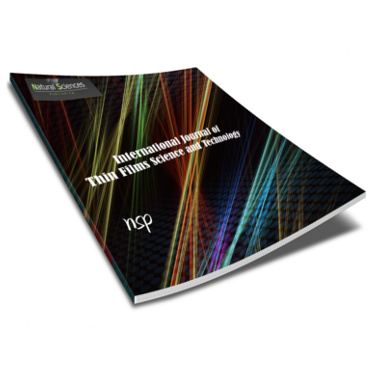International Journal of Thin Film Science and Technology

Abstract
Recently, the nanostructured thin films have attracted the research community all over the world, as they show impending applications in semiconductor industry, predominantly in fabrication of optoelectronic devices. Especially, in the case of chalcopyrite heterojunction solar cells, it acts as a buffer layer. These films are also used as photoconductors, photo-resistors, transistor image magnification etc. Recently it has been found that they find application in light activated systems for large screen Liquid Crystal Display. Thin films of CdS have received considerable attention towards other device applications such as electrochemical cells, gas sensors, and metal-Schottky barrier cells. It is mainly used as optical window material in solar cell. In the present investigation CdS & Nickel, Titanium and Zinc doped CdS thin films were deposited on a glass substrate by SILAR method at room temperature. The crystalline nature of the thin films is confirmed from X-Ray diffraction and all the thin films assume Hexagonal structure. The average particle size of CdS, CdNiS, CdTiS and CdZnS are found to be 13.86 nm, 18.08 nm, 18.77 nm and 26.04 nm respectively using Scherer formula. The corresponding dislocation density (δ) of the materials is calculated as 5.2056 X 1015 m-2, 3.0591 X 1015 m-2, 2.838 X 1015 m-2 and 1.4747 X 1015 m-2. Strain is found to be 0.7283, 0.6943, 0.6501 & 0.2051. The optical band gap energy (Eg) near the edge of absorption band is calculated as 3.7191 eV, 3.8195 eV, 3.8490 eV and 3.9651 eV using Tauc relation and UV-VIS spectroscopic data. The grown thin films are subjected to different excitation wave lengths and their corresponding emission wave lengths are observed from photoluminescence spectroscopy.
Recommended Citation
Munusamy, Gunasekaran and Perumal, Seenuvasakumaran
(2020)
"Structural and Optical Properties of Silar Deposited CdS and Ni, Ti & Zn DOPED CdS Thin Films,"
International Journal of Thin Film Science and Technology: Vol. 9
:
Iss.
3
, PP -.
Available at:
https://digitalcommons.aaru.edu.jo/ijtfst/vol9/iss3/3

